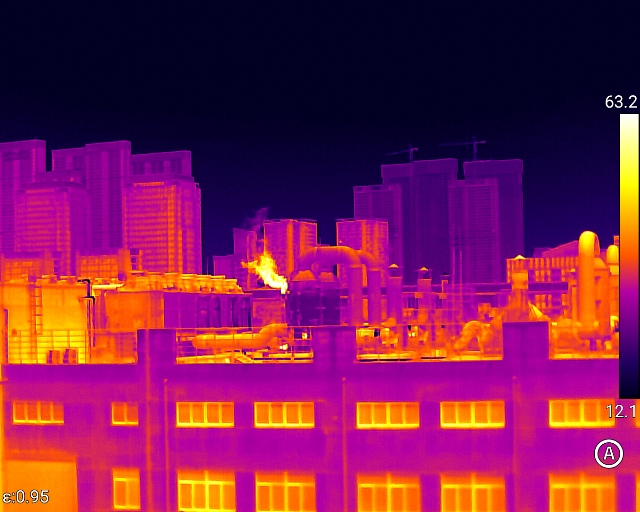Hazardous industry gases such as methane, propane, or poisonous fumes are typically invisible, making leaks difficult to detect. But thermal imaging cameras make all the difference. They take heat signatures and turn them into visible images, which enable workers to quickly and safely locate leaks. This guide explains how and why they work.
How Thermal Imaging Cameras "See" Invisible Gases
Most hazardous gases absorb or emit infrared radiation differently than the surrounding air. Thermal imaging cameras can detect these subtle temperature differences. When gas leaks, it creates a cooler or warmer area in the air, depending on the gas. For example, methane cools as it expands, in the form of a blue streak against a warmer background. A thermal imaging camera converts this into a clear image, as before concealed leaks become visible.
These cameras can operate even in dark, hazy, or foggy environments, unlike ordinary cameras, which require light. They do not even require direct contact with gases, allowing workers to stay away from toxic or explosive fumes and stay safe.
Faster than Traditional Methods
Traditional leak detection methods, such as using gas detectors or soapy water are slow and limited. Hand-held gas detectors can perform only one-point-at-a-time detection, and soapy water only works on visible pipes. Thermal imaging cameras can scan large areas in seconds, covering entire pipes, tanks, or valves in a single scan.
This speed is crucial. A small gas leak can quickly develop into an explosion or health hazard. Thermal imaging allows operators to detect leaks during routine inspections, even while on the move, saving time between leak occurrence and repair.
Worker Safety Benefits
Hazardous gases can be toxic, flammable, or cause asphyxiation. Using traditional tools to inspect leaks up close puts workers at risk. Thermal imaging cameras allow them to detect and document leaks from safe distances, sometimes up to 30 meters. It is particularly useful in contained environments like chemical plants or refineries where leaks tend to be in hard-to-reach locations.
They also reduce false alarms. While traditional detectors can mistake moisture or dust for gas, thermal imaging shows the actual motion of gas, making it easier to identify actual leaks from false readings.
Long-term Cost Savings
It is less expensive to fix leaks early. A small methane leak in a facility, if unaddressed, will waste fuel, increase energy costs, and even lead to penalties for violating environmental codes. Thermal infrared imaging cameras find leaks before they become large, and as such, repairs are less expensive.
They also reduce downtime. Instead of shutting down the entire system to scan for leaks using traditional methods, workers can simply scan while the equipment is running. This keeps production running and saves money on lost work time.
Adaptable to Diverse Environmental Conditions
Thermal infrared imaging cameras are designed to withstand most industrial environments. In high-temperature areas like furnaces or foundries, they can filter out unwanted background heat while highlighting temperature changes caused by gases. In high-humidity areas like paper mills, they are fog-resistant and maintain image clarity so that leaks are not hidden by water vapor. Even in vibration areas, i.e., near heavy machinery, their ruggedness prevents image distortion and has stable detection. This versatility guarantees stable functioning in an extensive variety of industrial applications, independent of the harshness of the environment.
Data Recording and Analysis Capabilities
Modern thermal imagers feature built-in storage and software that record leak images and temperature data. This allows employees to compare new scans with past records and track whether small leaks are growing over time. All this data can be shared instantly with maintenance crews or safety personnel by wireless capability, accelerating repair decisions. Additionally, analyzing this data can help identify patterns, such as frequent leaks in a particular pipeline section, enabling preventative maintenance to prevent future problems.
Practical Applications
Thermal imaging technology is used in numerous applications across different industries:
Oil and gas: Hydrocarbon leak detection from pipelines, storage tanks, and wellheads.
Chemical plants: Harmful gas detection of chemicals such as ammonia and chlorine.
Wastewater treatment: Methane gas leakage detection from rotting waste.
Power plants: Natural gas pipe leaks utilized for power generation.
They can travel through snow or frost in freezing weather; in hot climates, they remain unaffected by strong sunlight. They provide all-around year-round performance.
Environmental Protection and Compliance
Thermal imagers are important in helping businesses comply with environmental laws. Many countries have tight emission limits on harmful gases, such as methane, that cause the greenhouse effect. The cameras help businesses reduce unnecessary emissions and their carbon footprint through speedy leak detection. The data registered by these cameras may also be utilized as proof of compliance during environmental audits that demonstrate that firms are actively catching and repairing leaks. This not only avoids the payment of fines but also strengthens a company's reputation as an environmentally friendly firm.
Thermal imaging cameras are revolutionizing the identification of lethal industrial gas leaks. They translate unseen hazards into visible images, enabling rapid detection, ensuring employees' safety, and conserving capital. Their capacity to suit a range of conditions, process data analysis, and impact environmental conservation and regulatory compliance further makes them more valuable. By identifying leaks at early stages and in inaccessible locations, they allow factories, refineries, and power plants to operate more efficiently and safely. Guide Sensmart, a thermal imaging camera manufacturer, looks forward to working with you.













.svg)


(1).jpg)
(1).jpg)

